1997 CHEVROLET MONTE CARLO child restraint
[x] Cancel search: child restraintPage 51 of 358
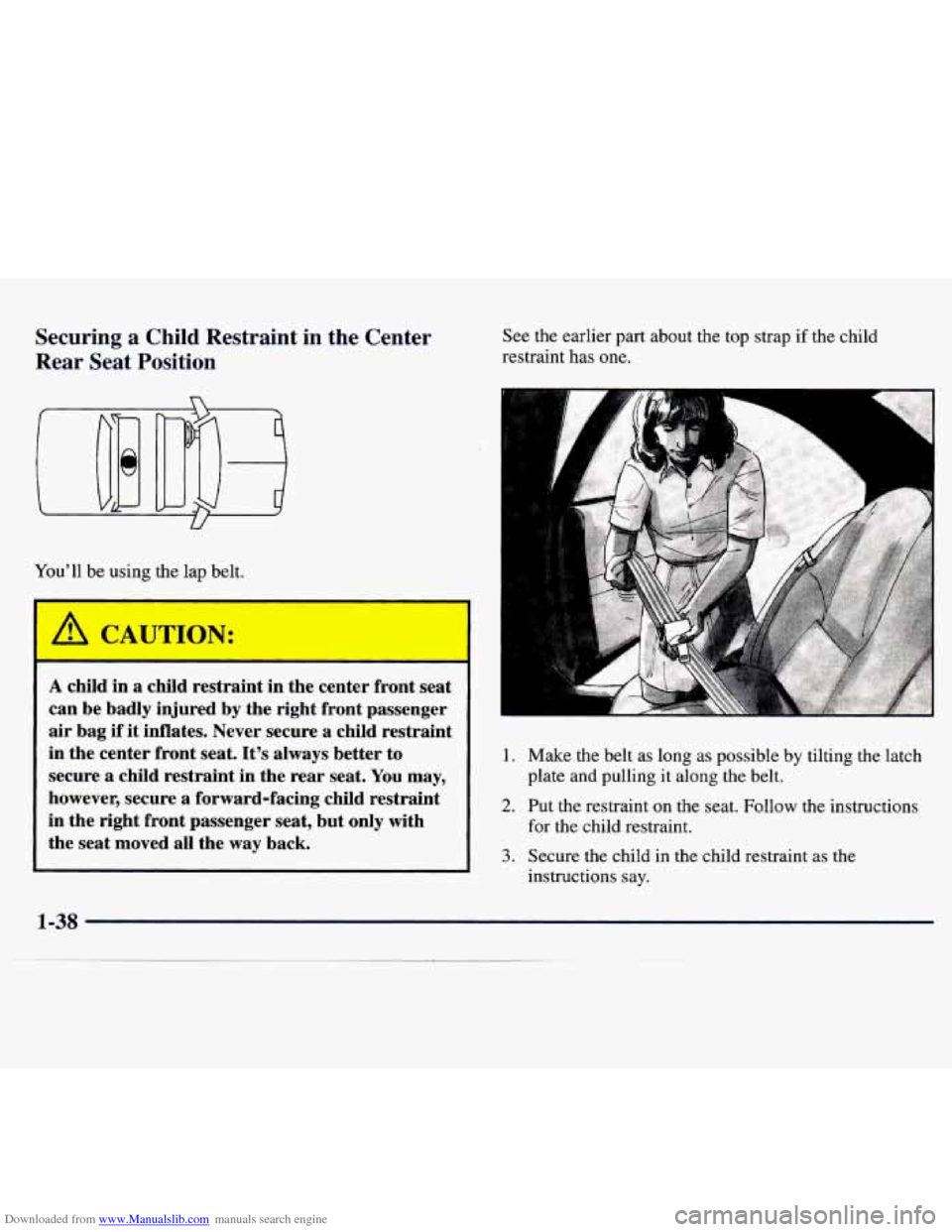
Downloaded from www.Manualslib.com manuals search engine Securing a Child Restraint in the Center
Rear Seat Position See the earlier part about the top strap if the child
restraint has one.
U
You’ll be using the lap belt.
A child in a child restraint in the center front seat
can be badly injured by the right front passenger
air bag if it inflates. Never secure a child restraint
in the center front seat. It’s always better to
secure a child restraint in the rear seat. You may,
however, secure a forward-facing child restraint
in the right front passenger seat, but only with
the seat moved all the way back.
1. Make the belt as long as possible by tilting the latch
2. Put the restraint on the seat. Follow the instructions
plate and pulling
it along the belt.
for the child restraint.
3. Secure the child in the child restraint as the
instructions say.
1-38
Page 52 of 358
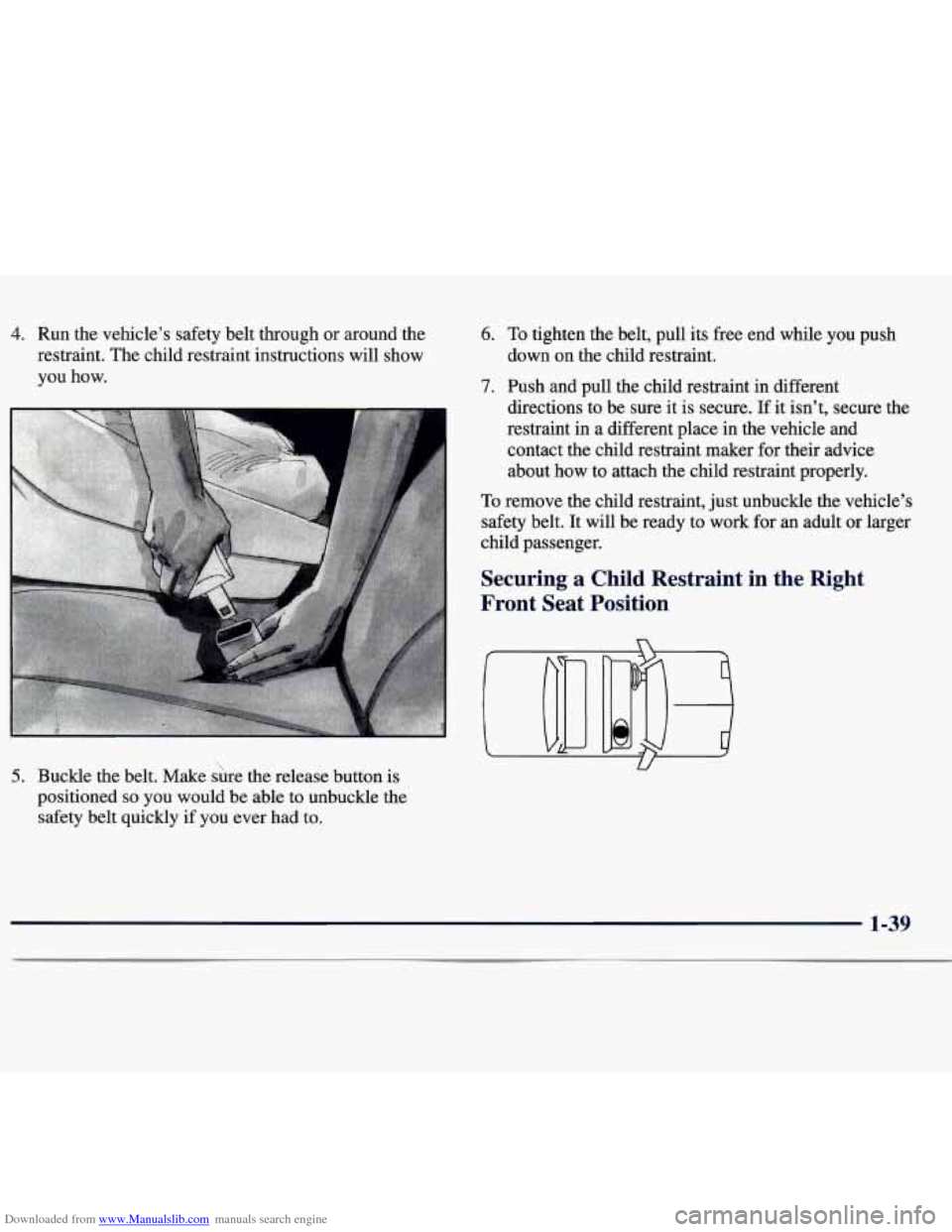
Downloaded from www.Manualslib.com manuals search engine 4. Run the vehicle’s safety belt through or around the
restraint. The child restraint instructions will show
you
how.
5. Buckle the belt. Make sure the release button is
positioned
so you would be able to unbuckle the
safety belt quickly if you ever had to.
6. To tighten the belt, pull its free end while you push
7. Push and pull the child restraint in different
down
on the child restraint.
directions to be sure it is secure. If it isn’t, secure the
restraint in a different place in the vehicle and
contact the child restraint maker for their advice
about how to attach the child restraint properly.
To remove the child restraint, just unbuckle the vehicle’s
safety belt. It will be ready to work for
an adult or larger
child passenger.
Securing a Child Restraint in the Right
Front Seat Position
U
1-39
Page 53 of 358
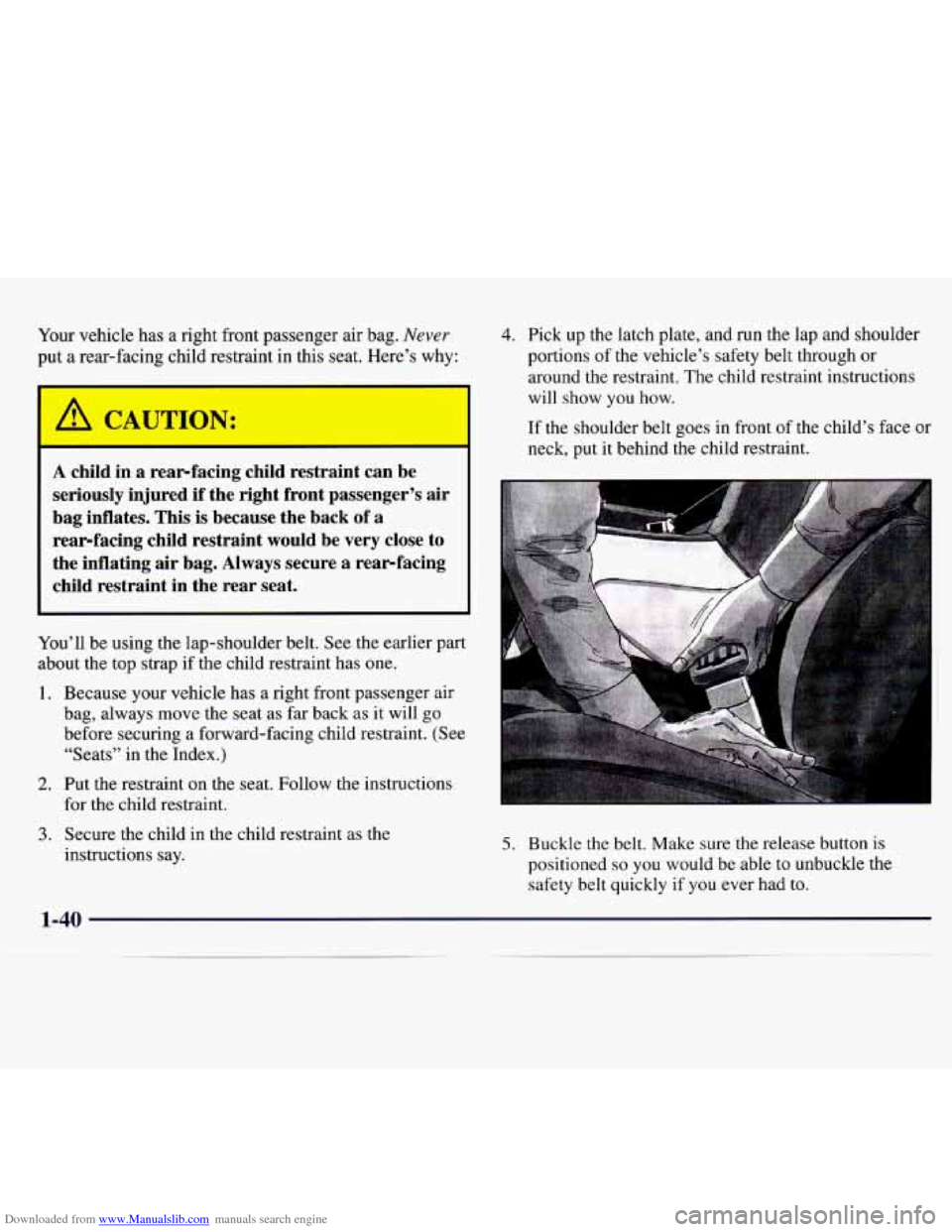
Downloaded from www.Manualslib.com manuals search engine Your vehicle has a right front passenger air bag. Never
put a rear-facing child restraint in this seat. Here’s why:
1 A CAUTION: I
I I
A child in a rear-facing child restraint can be
seriously injured if the right front passenger’s air
bag inflates. This
is because the back of a
rear-facing child restraint would be very close to
the inflating air bag. Always secure a rearfacing
child restraint in the rear seat.
You’ll be using the lap-shoulder belt. See the earlier part
about the top strap if the child restraint has
one.
1. Because your vehicle has a right front passenger air
bag, always move the seat as far back as it will go
before securing a forward-facing child restraint. (See
“Seats”
in the Index.)
2. Put the restraint on the seat. Follow the instructions
for the child restraint.
3. Secure the child in the child restraint as the
instructions say.
4. Pick up the latch plate, and run the lap and shoulder
portions
of the vehicle’s safety belt through or
around the restraint. The child restraint instructions
will show
you how.
If the shoulder belt goes in front
of the child’s face or
neck, put it behind the child restraint.
5. Buckle the belt. Make sure the release button is
positioned
so you would be able to unbuckle the
safety belt quickly if you ever had
to.
1-40
Page 54 of 358
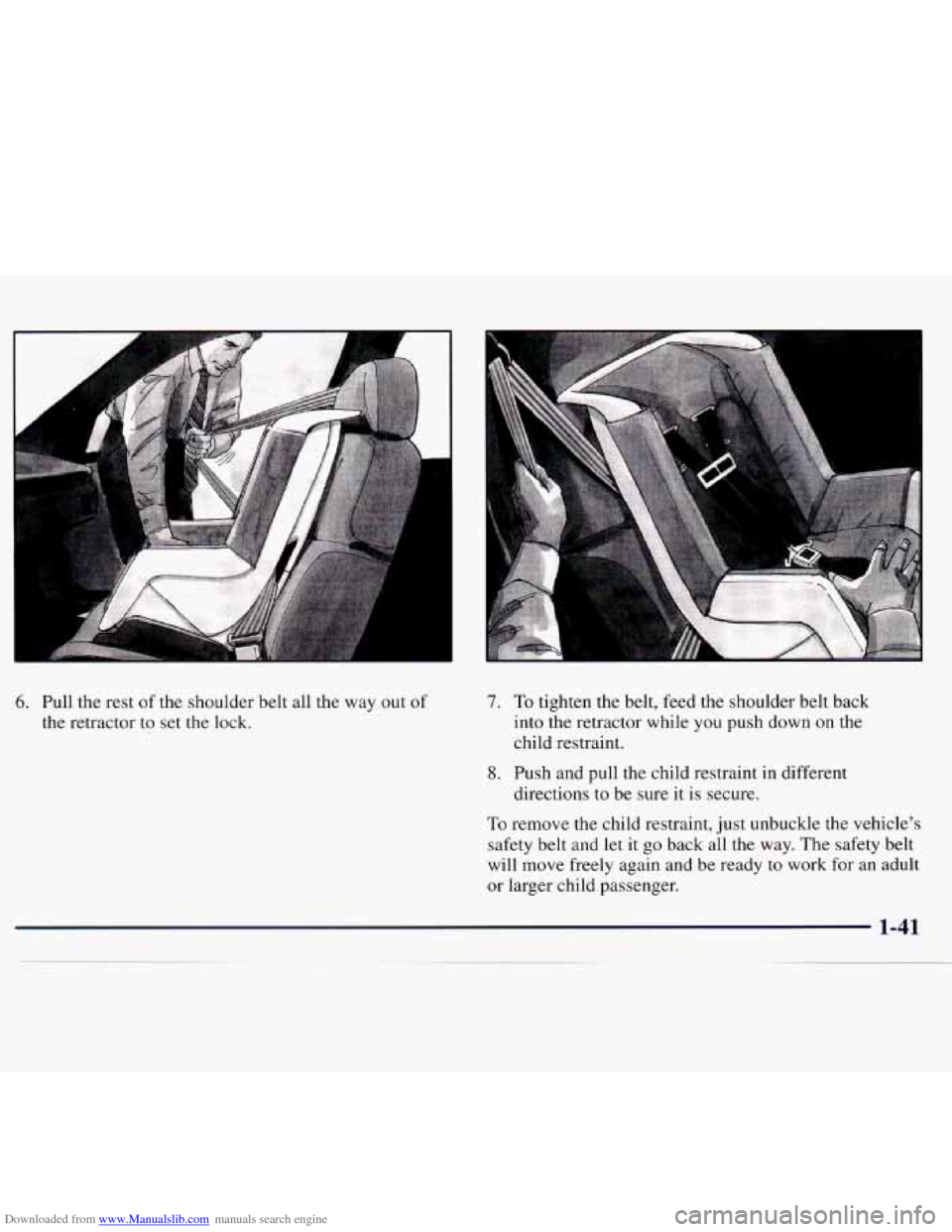
Downloaded from www.Manualslib.com manuals search engine 6. Pull the rest of the shoulder belt all the way out of
the retractor to set the lock.
7. To tighten the belt, feed the shoulder belt back
into the retractor while you push down on the
child restraint.
8. Push and pull the child restraint in different
directions to be sure it is secure.
To remove the child restraint, just unbuckle the vehicle’s
safety belt and let it
go back all the way. The safety belt
will move freely again and be ready to work for an adult
or larger child passenger.
Page 55 of 358

Downloaded from www.Manualslib.com manuals search engine Larger Children
Children who have outgrown child restraints should
wear the vehicle’s safety belts.
If you have the choice, a child should sit next to a
window
so the child can wear a lap-shoulder belt and
get the additional restraint
a shoulder belt can provide.
Accident statistics show that children are safer if they
are restrained in the rear seat. But they need to use the
safety belts properly.
Children who aren’t buckled up can be thrown out in
a crash.
Children who aren’t buckled up can strike other
people who are.
Page 56 of 358
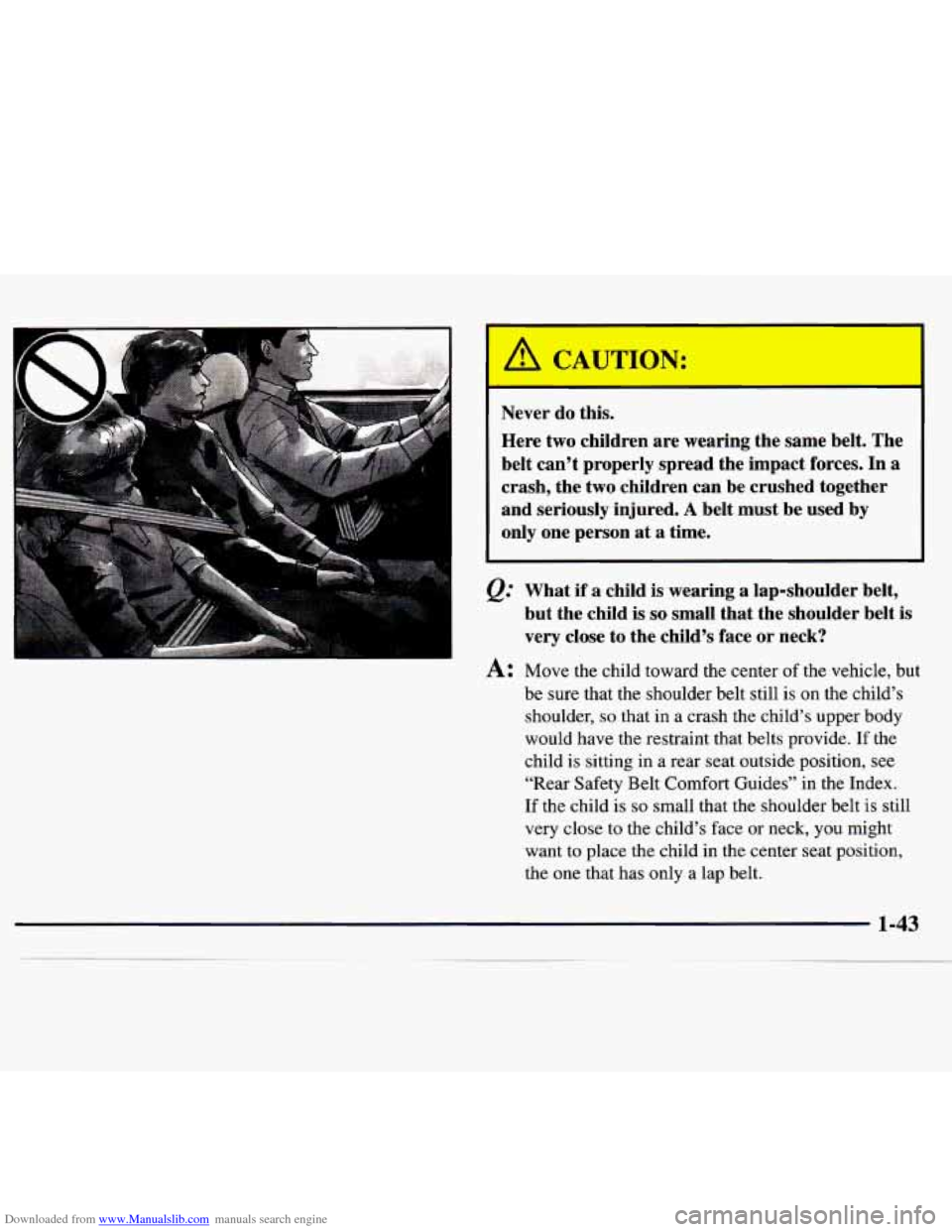
Downloaded from www.Manualslib.com manuals search engine Never do this.
Here two children are wearing the same belt. The
belt can’t properly spread the impact forces. In a
crash, the two children can
be crushed together
and seriously injured.
A belt must be used by
only one person at a time.
&: What if a child is wearing a lap-shoulder belt,
but the child is
so small that the shoulder belt is
very close to the child’s face or neck?
A: Move the child toward the center of the vehicle, but
be sure that the shoulder belt still is on the child’s
shoulder,
so that in a crash the child’s upper body
would have the restraint that belts provide.
If the
child is sitting in a rear seat outside position, see
“Rear Safety Belt Comfort Guides” in the Index.
If the child is
so small that the shoulder belt is still
very close to the child’s face or neck,
you might
want
to place the child in the center seat position,
the one that has only a lap belt.
Page 169 of 358
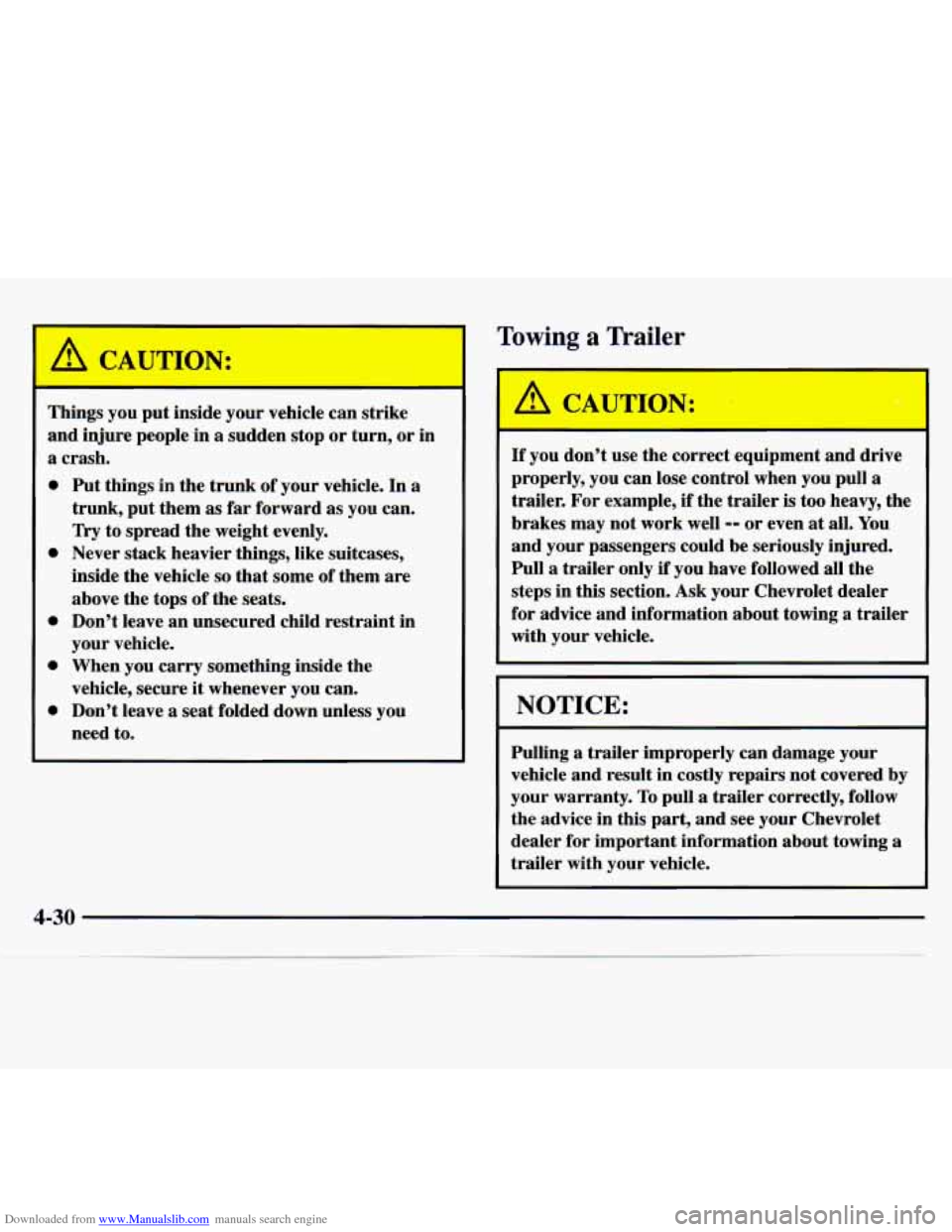
Downloaded from www.Manualslib.com manuals search engine A CAUTION:
Things you put inside your vehicle can strike
and injure people
in a sudden stop or turn, or in
a crash.
0
0
e
0
0
Put things in the trunk of your vehicle. In a
trunk, put them as far forward as you can.
Try to spread the weight evenly.
Never stack heavier things, like suitcases,
inside the vehicle
so that some of them are
above the tops of the seats.
Don’t leave an unsecured child restraint in
your vehicle.
When you carry something inside the
vehicle, secure
it whenever you can.
Don’t leave
a seat folded down unless you
need to.
Towing a Trailer
A CAUTION:
I
If you don’t use the correct equipment and drive
properly, you can lose control when you pull
a
trailer. For example, if the trailer is too heavy, the
brakes may not work well
-- or even at all. You
and your passengers could be seriously injured.
Pull
a trailer only if you have followed all the
steps in this section. Ask your Chevrolet dealer
for advice and information about towing a trailer
with your vehicle.
NOTICE:
Pulling a trailer improperly can damage your
vehicle and result in costly repairs not covered
by
your warranty. To pull a trailer correctly, follow
the advice in this part, and see your Chevrolet
dealer for important information about towing a
trailer with your vehicle.
Page 347 of 358

Downloaded from www.Manualslib.com manuals search engine Brake Adjustment
.................................. 6-30
Fluid
....................................... 6-27
Master Cylinder
.............................. 6-27
Replacing System Parts
........................ 6-30
System Warning Light
.................... 2-50, 6-28
Trailer
...................................... 4-34
Transaxle Shift Interlock
....................... 2-24
Transaxle Shift Interlock Check
.................. 7-39
Brakes, Anti-Lock
............................... 4-7
Braking
........................................ 4-6
Braking in Emergencies
........................... 4-9
Break-In, New Vehicle
.......................... 2- 12
Brightness Control
.............................. 2-34
BTSI
......................................... 2-24
Bulb Replacement
.............................. 6-3 1
Canadian Roadside Assistance .................... 8-7
Capacities and Specifications
...................... 6-63
Carbon Monoxide
................ 2-8,2-25,4-27, 4-33
Cassette Deck Service
........................... 7-37
Cassette Tape Player
............................. 3-7
Cassette Tape Player Care
........................ 3- 19
Center High-Mounted Stoplamp Bulb Replacement
.... 6-34
Center Passenger Position
........................ 1-26
CertificationLabel
.............................. 4-29
Chains, Safety
................................. 4-34
Chains. Tire
................................... 6-45
Parking
..................................... 2-20
PedalTravel
................................. 6-30
Wear
....................................... 6-29
BTSICheck
................................... 7-39 Change Oil Soon Light
.......................... 2-58
Changing a Flat Tire
............................. 5-24
Charging System Light
.......................... 2-49
Checking Your Restraint Systems
.................. 1-45
Chemical Paint Spotting
.......................... 6-53
Child Restraints
................................ 1-34
Securing
in a Rear Outside Seat Position ........... 1-36
Securing
in the Center Rear Seat Position .......... 1-38
Securing in the Passenger Seat Position
........... 1-39
Securing in the Right Front Seat Position
.......... 1-39
TopStrap
....,.....,......,................. l-35
WheretoPut ................................ 1-34
Cigarette Lighter
............................... 2-39
Circuit Breakers and Fuses
....................... 6-56
Cleaner, Air
................................... 6-16
Cleaning
...................................... 6-46
Aluminum Wheels
............................ 6-52
Exterior Lampshenses
........................ 6-51
Glass Surfaces ............................... 6-50
Inside of Your Chevrolet
....................... 6-46
Outside
of Your Chevrolet ...................... 6-51
Special Problems ............................. 6-48
Vinyl
....................................... 6-49
Windshield and Wiper Blades
................... 6-50
Fabric
...................................... 6-46
FabricProtection
............................. 6-47
Instrumentpanel
............................. 6-49
Leather
..................................... 6-49
SafetyBelts
................................. 6-50
Stains
...................................... 6-46
Tires
....................................... 6-52
Wheels
..................................... 6-51
9-2